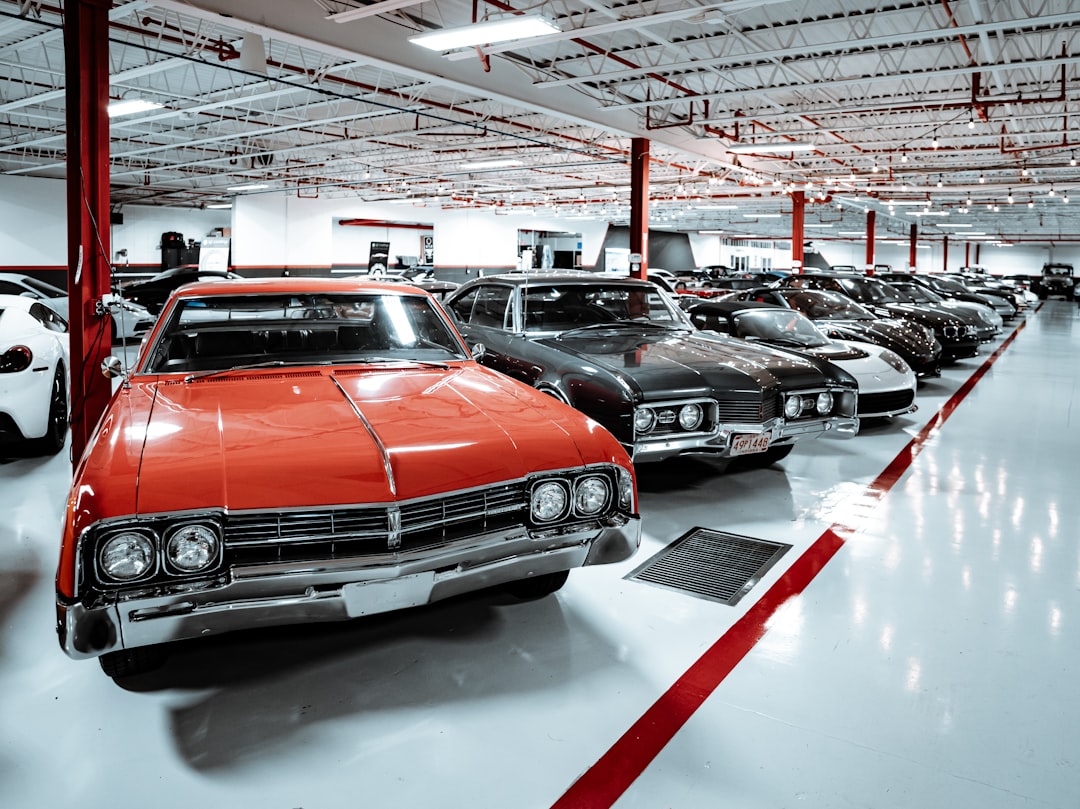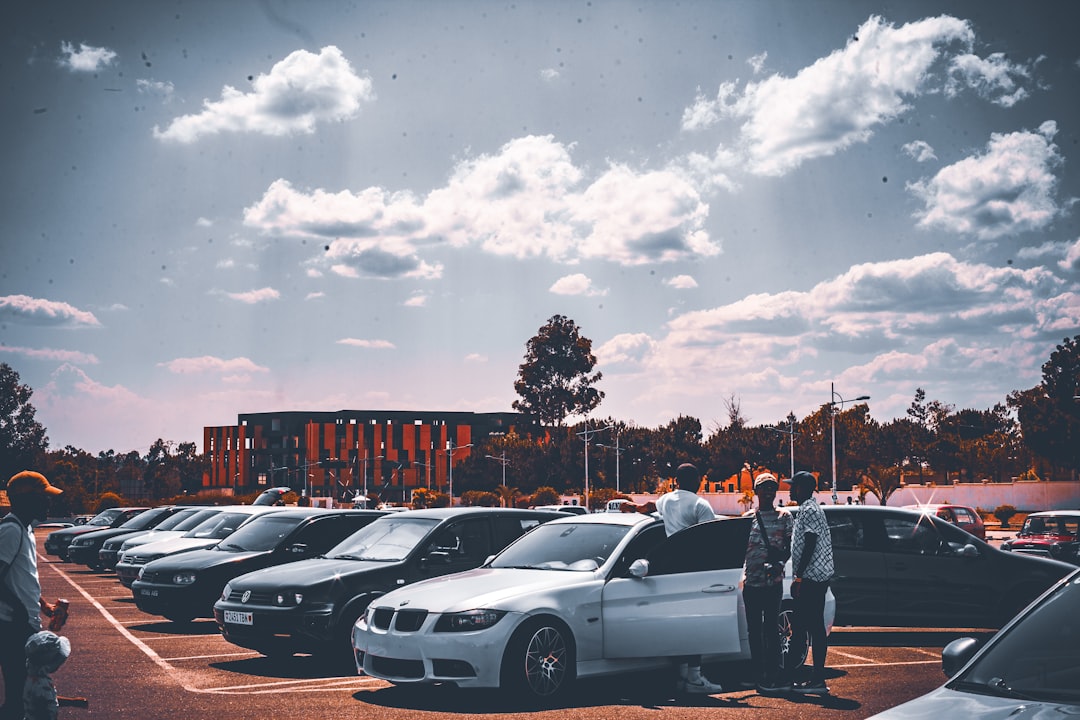

Engage prospects with a scan and streamline customer engagement with FREE QR code marketing tools by Sona – no strings attached!
Create a Free QR CodeFree consultation

No commitment

Engage prospects with a scan and streamline customer engagement with FREE QR code marketing tools by Sona – no strings attached!
Create a Free QR CodeFree consultation

No commitment
In today’s digitally driven market, custom car dealerships face intensifying pressure to deliver a seamless and highly personalized experience for automotive enthusiasts. Yet, capturing high-value prospects at every touchpoint remains a persistent challenge; customers routinely browse showrooms, attend car meets, or pore over printed brochures without leaving any trace in dealership CRMs. These gaps can result in missed opportunities, incomplete data, and sluggish follow-up, giving competitors an opening to engage first.
QR codes have emerged as a powerful and app-free solution for bridging these divides, directly connecting offline interactions to automated digital journeys. They offer a practical way for custom car dealerships to capture quality leads, surface immediate buyer intent for rare modifications, and collect real-time feedback on unique offerings before competitors do. Instead of waiting for a form fill or phone call, modern QR-powered workflows allow dealers to recognize high-fit prospects at the moment of interest and guide them toward the right digital path based on their preferences.
This article provides actionable guidance for custom car dealerships aiming to use QR codes to capture and convert buyer demand, respond swiftly to interest, and refine their services based on real customer signals. Learn how to overcome lead-tracking hurdles, create personalized buying experiences, and ensure every customer encounter translates into future revenue and brand loyalty.

Custom car dealerships often lose high-value prospects because showroom visitors and event attendees interact with vehicles and marketing materials without leaving their information. Manual processes such as paper sign-up sheets, static forms, or staff-dependent follow-up can result in untapped opportunities that never reach the CRM. When that happens, it becomes nearly impossible to act on genuine buying intent in time, especially for scarce parts, limited builds, or rare donor vehicles.
QR codes remove friction by inviting prospects to self-identify at the precise moment of interest. A single scan moves them into a guided digital journey that can capture context, preferences, and intent, often via Google Forms while offering immediate value such as a build preview, test drive slot, or financing pre-qualification. The result is a higher volume of qualified leads, faster speed to contact, and a cleaner dataset for retargeting and sales prioritization.
To execute effectively, replace analog bottlenecks with QR-enabled flows that reduce latency. For example, instead of handing out printed brochures that go untracked, place a QR code on each spec sheet that opens a mobile configurator and captures a name and email before revealing the build summary. Replace paper sign-up forms at meets with a QR-enabled RSVP that writes directly to your CRM and assigns a tag for the event. Transition from untracked phone inquiries to QR-driven service or financing forms that automatically route to the right team with standardized data fields.
When you design your QR program, define success metrics upfront. Examples include scan-to-lead conversion rate, average time from scan to first contact, test drive or consultation bookings per 100 scans, and scan-to-sale conversion by vehicle category. With a platform such as Sona QR, you can track scans in real time, run A/B tests on landing pages, and sync clean records to your CRM so sales and service teams can act on the same source of truth.
By streamlining lead capture, tracking engagement signals automatically, and moving beyond reliance on manual follow-up, custom car dealerships can ensure that every qualified prospect is surfaced and nurtured. This lays the foundation for higher conversion rates, cleaner attribution, and sustainable growth fueled by real buyer interest.

The traditional custom car dealership experience is riddled with offline-to-online friction. Customers explore vehicles on the lot, flip through glossy brochures, and attend car meets or track days without ever submitting a form. When interest is expressed verbally or through casual browsing, dealerships have limited visibility into who is likely to buy or which build categories are gathering momentum. The gap leads to delayed outreach, missed revenue, and lost opportunities for tailored follow-up.
QR codes change that dynamic by making every physical touchpoint actionable. A scan on a build placard can unlock a guided configurator, a financing estimator, or a service appointment in seconds. For the dealership, that same scan records context such as location, time, and campaign source, which transforms offline curiosity into digital intent. With scans feeding directly into CRM and marketing platforms, sales teams gain the ability to react in minutes rather than days, and marketers can optimize which models and modifications to spotlight next. Explore Sona QR’s automotive strategies.
Common applications include interactive modification previews in showrooms, contact card codes for sales consultants on business cards or placards, and event-specific codes that accelerate follow-up after car meets or auto shows. By making each step measurable, QR programs let you prioritize the right conversations and personalize the journey from the first scan through final delivery.

A core challenge for custom car dealerships is matching each shopper with the most relevant digital action while capturing the data needed for personalized follow-up. One-size-fits-all tactics and generic analytics fail to reveal nuanced preferences, such as interest in a stage 3 performance tune versus a period-correct restoration. QR codes solve this by combining precise formats with specific destinations that map to buyer intent.
Choose the formats that align with how your customers prefer to engage. Some buyers want to book immediately; others want to save a contact or configure in their own time. Dynamic QR codes add another layer by allowing content changes after print and by enabling analytics that reveal what is resonating across vehicles and contexts.
Dynamic versus static depends on your goals. Static QR codes work for evergreen resources such as a general brochure PDF or a service hours page. Dynamic QR codes are recommended for any asset where you want analytics, flexibility, or personalization. That includes campaigns, event signage, inventory sheets, and seasonal offers. With Sona QR, all formats can be managed centrally, updated instantly, and tracked in real time, which keeps printed materials useful even as your product mix evolves.

Even passionate enthusiasts can slip through the cracks if their interest is not captured while it is hot. You might see robust showroom traffic, enthusiastic conversations at car meets, and plenty of brochure pickups, yet still end up with too few names in the CRM. The opportunity is to place QR codes where intent is strongest and to make the scan the easiest path forward for the shopper.
Think about the physical environments that drive decisions and the questions buyers ask in those moments. Use the scan to answer that question and to log the signal. For example, a code next to a brake upgrade display can open a short video and a quote request. A code on a high-performance build sheet can trigger an alert to the right specialist when it is scanned, along with the model and package selected.
Strategic placement turns every physical asset into a performance channel. It also makes your campaigns more adaptive. As you observe which placements produce qualified leads, you can redeploy budgets, refine CTAs, and shift inventory strategy toward what demand signals reveal.

QR codes excel when they connect a tangible moment of curiosity to a specific next action. In custom car settings, this often means moving from admiration to configuration, from questions to appointments, or from research to financing. When executed well, each use case improves the customer experience and removes friction for your team.
Focus on practical workflows that reduce manual work and standardize data capture. A showroom visitor who scans a test drive QR should enter the same flow and fields as an online lead. A meet attendee who scans a demo car should trigger the same alert and lead score as a showroom scan. This consistency makes pipeline forecasts more reliable and allows you to compare performance across channels.
Each of these use cases replaces manual tracking with automated intent capture. They also encourage prospects to take action in the moment, which improves the accuracy of your lead scoring and the quality of your pipeline.
Every QR scan reveals something about the scanner’s intent and context. With a thoughtful deployment strategy, those signals can be turned into segmented audiences that you can retarget across email, SMS, and paid media. The goal is to nurture each group with content and offers that match their build preferences and buying stage, not to blast everyone with generic promotions.
Start by mapping primary journeys. Awareness scans often come from events and out-of-home placements. Consideration scans happen in showrooms on build sheets and parts displays. Conversion scans come from pricing pages, appointment forms, and financing. Use separate QR codes for each stage so you can retarget people with content that advances them to the next step rather than starting over.
Sona is an AI-powered marketing platform that turns first-party data into revenue through automated attribution, data activation, and workflow orchestration. For advanced retargeting flows, see Sona’s playbook Intent-driven retargeting. With Sona QR, each code acts as a smart entry point, capturing the details you need to retarget based on real behavior rather than assumptions.
QR codes do more than bridge a single gap. They unify offline and online programs into a connected funnel where every interaction is measurable. This is especially valuable in custom automotive sales where interest can span months and multiple touchpoints. The more consistent and connected the journey, the easier it is to guide prospects along without losing momentum.
When you add QR codes to the channels you already use, you enrich both sides. Print and in-store assets become instantly actionable. Digital campaigns gain valuable first-party data from scans and form fills. Your teams gain visibility into what is working at the asset and campaign level, which improves budget allocation and future creative.
QR codes become the offline onramp to your digital marketing engine. With a centralized platform such as Sona QR, you can manage all codes, monitor performance in one dashboard, and sync scan data with your CRM and ad platforms. This turns disparate activities into a cohesive program that compounds results.
Execution gaps lead to missed results. The most common pitfalls include unclear CTAs, poor placement, unstable landing pages, and no follow-up automation. A simple, repeatable process reduces risk and accelerates time to value.
Use the following steps to plan, launch, and optimize QR campaigns that fit how custom car buyers actually shop. Each step includes practical guidance and examples tailored to showrooms, events, and service environments.
Clarify the outcome you want. For custom car dealerships, the highest leverage use cases often include consultation bookings for builds, financing pre-qualification, test drive RSVPs, or service-to-upgrade offers. Pick one primary goal per code so your CTA and destination can be laser focused.
Align each use case with a business bottleneck. If your team struggles to secure consults during busy weekends, deploy a Scan to book your build consult code on placards and at the front desk. If follow-up after car meets is inconsistent, print event-specific codes for demo cars that deliver a short interest form and a time-bound incentive.
Select the QR format that best supports your goal. For trackable, editable experiences, dynamic QR codes are the default choice. They allow destination updates, split tests, and analytics without reprinting. Use static codes only for fixed, evergreen resources where you do not need data.
For custom car environments, most high-impact placements benefit from dynamic codes. These include build sheets, showroom signage, direct mail, event banners, and service invoices. With Sona QR, you can generate both static and dynamic codes, apply brand styling, and manage them in one library.
Design with intent. Include your logo, brand colors, and a clear frame or callout so the code stands out. Place a benefit-driven CTA next to the code such as Scan to build your dream car, Scan for instant quote, or Scan to reserve a test drive. Keep the code size generous for the viewing distance and print medium.
Test across devices and conditions. Confirm the code scans well on iOS and Android, in different lighting, and at varying angles. Test the full journey on mobile, including form speed, autofill, and confirmation messages. Your landing page should load fast, match the CTA, and ask for only the essential fields.
Map code types to your highest value touchpoints. In showrooms, place codes on build placards, near accessories displays, and at counters. At events, use codes on demo cars, banners, and lanyards. In direct mail, place codes near the main offer to drive response. On out-of-home, keep the CTA short and incentive clear.
Stagger deployments to test and learn. Start with a few vehicles or one event to establish benchmarks for scan rate, form completion, and bookings per 100 scans. Adjust creative and placement before scaling across the full inventory or events calendar.
Treat each scan as a data point that can improve your next decision. Monitor scan volume by day and location. Watch conversion rates from scan to form completion and from form completion to appointment or sale. Pay attention to drop-off points such as slow pages or long forms.
Optimize weekly. Refine CTAs, reposition codes, test new landing pages, and experiment with incentives. Feed insights back into creative, inventory spotlighting, and event planning. With Sona QR, you can view real-time analytics and push scan events into your CRM to trigger alerts, workflows, and lead scoring without manual work.
A short debrief after each campaign cycle cements learning. Document which placements, CTAs, and offers drove the best results. Roll those lessons into your next print run, showroom refresh, or event kit so performance improves quarter over quarter.
Without granular analytics, it is easy to spend on flashy assets that generate interest but not impact. Traditional web analytics rarely capture what happens at offline touchpoints, which means important engagement goes unrecorded and unconnected to revenue. The remedy is to track the full path from scan to sale and to use those insights to reallocate spend toward what works.
Modern QR solutions do more than count scans. They provide context such as location, time, device, and campaign source, and they make it possible to join scan data with downstream outcomes such as booked appointments and closed deals. When each scan is tied to a CRM record, you can see how often individual leads engage, how quickly follow-ups happen, and which placements drive pipeline.
Aim for clear benchmarks. Healthy scan-to-lead conversion often ranges from 20 to 40 percent for showroom codes and 10 to 25 percent for event or out-of-home codes, depending on the offer and placement. Track scan-to-appointment and scan-to-sale rates by vehicle category so you can prioritize high performers. Over time, the feedback loop between scans, engagement, and outcomes will refine your messaging, inventory focus, and sales motions.
QR campaigns underperform when every channel uses the same code, when CTAs are vague, or when follow-up automation is missing. Small improvements in design, placement, and post-scan workflows can compound into significant gains in conversion and revenue. The key is to plan for action after the scan and to make each code unique and measurable.
Invest in staff enablement as well as creative. Ask sales and service teams to explain what happens when a customer scans and to highlight the benefits, such as instant quotes, exclusive events, or early access to build slots. When customers know what to expect, they are far more likely to scan.
Creative deployment ideas add lift. Place a QR code on delivery-day key tags that links to a short review request and a referral offer. Add a code to the dyno room glass that opens a video library and a quote request for performance packages. Use a QR on a show car’s build plate that opens a behind-the-scenes walkthrough and a consult booking flow. These touches feel native to the enthusiast experience and create measurable pathways to action.
Custom car dealerships that rely solely on passive promotion or manual tracking will continue to miss high-fit prospects as competitors adopt smarter, connected tactics. QR codes are more than a convenience. They are a strategy for eliminating lead leakage, surfacing real buyer intent, and building a measurable funnel from every physical surface in your ecosystem. When each scan ties to a clear next step and a CRM record, you gain the speed and precision needed to win in a fast-moving market.
For custom car retailers, QR technology transforms every showroom visit, event, and mailer into an opportunity that can be captured and nurtured. By addressing common pain points such as anonymous traffic, delayed follow-up, and fragmented data, QR-enabled workflows turn curiosity into booked appointments, pre-qualification, and sales. With Sona QR, you can generate and manage dynamic codes, track performance in real time, and connect scans to revenue through Sona.com’s attribution tools. Start creating QR codes for free.
QR codes have transformed custom car dealerships from traditional lead capture methods into dynamic, measurable growth engines. Whether it’s acquiring new customers, enhancing the showroom experience, or streamlining test-drive bookings, QR codes replace cumbersome processes with instant, mobile-friendly actions—capturing real-time data that turns every interaction into a high-value sales opportunity. Imagine instantly knowing which vehicle displays or promotions generate the most leads and being able to adjust your strategy on the fly.
With Sona QR, you can create dynamic, trackable QR codes in seconds, update campaigns without reprinting, and directly connect every scan to revenue outcomes. No more missed chances or guesswork—just smarter, more efficient lead capture that drives your dealership forward. Start for free with Sona QR today and turn every scan into a conversation, a qualified lead, or a closed deal.
Custom car dealerships offer highly personalized buying experiences with options for unique modifications, interactive build previews, and direct access to specialized consultations and financing.
Custom car dealerships focus on tailored vehicle modifications and niche build categories, using tools like QR codes to capture detailed buyer intent and provide personalized digital journeys unlike traditional dealerships.
You can expect a range of customizations including high-performance tuning, luxury upgrades, off-road packages, classic restorations, and electric conversions.
The article does not specify exact costs, but customizations vary widely depending on build complexity and parts; dealerships often provide instant quotes and financing pre-qualification via QR code workflows.
The article does not list specific dealerships but recommends using QR code strategies to identify and engage with high-quality custom car dealerships locally.
By deploying QR codes on assets like build sheets and event signage, dealerships can capture buyer intent instantly, automate follow-up, and sync data directly to their CRM for faster and more accurate lead conversion.
QR codes bridge offline and online interactions by turning physical assets into digital gateways, enabling immediate lead capture, personalized customer journeys, and real-time tracking of engagement.
Common formats include web links to configurators, vCards for sales contacts, lead capture forms for bookings and financing, SMS or email triggers for inquiries, and app download links for customer portals.
Effective placements include showroom build sheets, vehicle placards, event demo cars, window decals, direct mail offers, service invoices, and event signage where buyer intent is highest.
They trigger automated workflows immediately after scanning, such as sending confirmation messages, assigning sales tasks, and logging data in CRMs, ensuring no leads are missed.
Dealerships can segment audiences by scan context, build preference, and buyer journey stage, then sync this data to CRM and ad platforms to deliver targeted email, SMS, and paid media campaigns.
They should choose a clear use case, select the appropriate QR code type, design and test for usability, deploy across high-impact channels, and continuously track and optimize campaign performance.
Dynamic QR codes allow destination updates without reprinting, enable split testing and analytics, and help maintain up-to-date offers and inventory information.
Key metrics include scan-to-lead conversion, time from scan to contact, test drive bookings per scans, scan-to-sale rates, and performance by vehicle model and channel.
By eliminating lead leakage, capturing real-time buyer intent, enabling personalized follow-up, and providing measurable data to refine marketing and sales strategies.
Avoid using the same QR code across all channels, vague calls to action, poor placement, unstable landing pages, and lack of automated follow-up processes.
Use Sona QR's trackable codes to improve customer acquisition and engagement today.
Create Your FREE Trackable QR Code in SecondsJoin results-focused teams combining Sona Platform automation with advanced Google Ads strategies to scale lead generation

Connect your existing CRM

Free Account Enrichment

No setup fees
No commitment required

Free consultation

Get a custom Google Ads roadmap for your business






Launch campaigns that generate qualified leads in 30 days or less.
